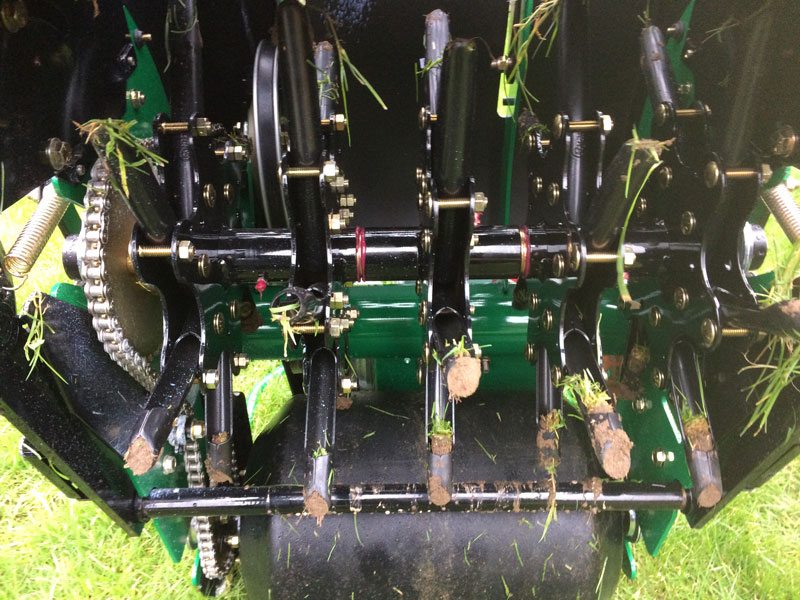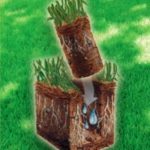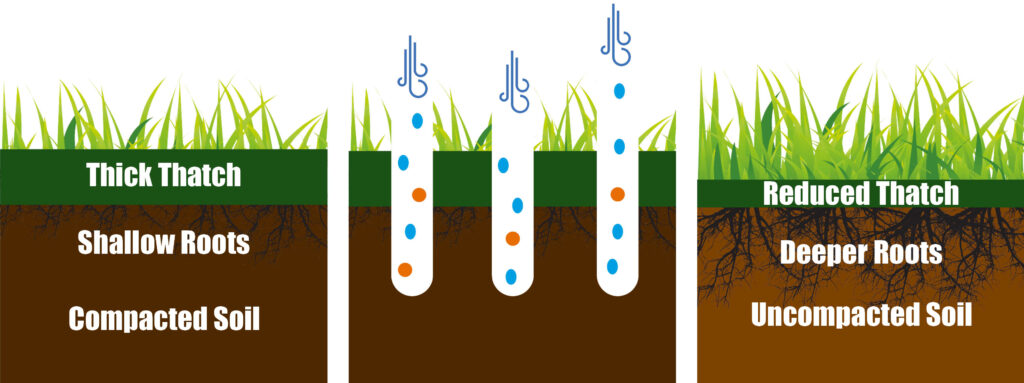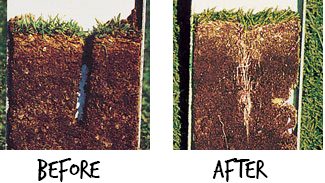

Hollow-tine Aeration is the process of taking small plugs from the lawn. Hollow-tines are pressed in to the lawn, and a small plug of soil is removed by each tine. The plug is then deposited on the surface of the lawn.


What is the purpose of Hollow-tine Aeration?
Air is one of your lawn’s vital elements alongside water, nutrients and sunlight. Increasing the airflow to the root zone is an important phase of lawn maintenance and should be carried out annually.
Over time, most soils will become compacted as the particles squash together, reducing the grass’s ability to grow well. This compaction will itself cause a number of problems and will increase the likelihood of the lawn becoming flooded or water-logged.


Compacted soils are much more likely to become infested with either moss, or weeds such as daisies and dandelions.
In compacted soils, the roots are unable to grow and reproduce and therefore unable to access the nutrients they require. The grass plants will start to grow tufted and bare patches will start to appear over time.
Grass also tends to be weak and pale in compacted soils. Improving the airflow will help new roots to develop, and in turn will help keep your lawn thick and healthy by maintaining the overall health of your lawn.


Hollow-tine Aeration is also the best way of easing thatch as the increased amount of air, water and fertiliser penetrating to the root zone will help to break thatch down naturally. This is particularly effective at the beginning and end of the growing season.
Hollow-tine aeration can leave your lawn looking a little worse-for-wear, but this is for only a short period of time.
What will happen if I don't Hollow-tine Aerate my lawn?
As the soil becomes more compact, the grass plants in your your lawn will finder it harder to grow properly. Root growth will be limited, and access to nutrients and water will become restricted.
The most common issues to arise from compacted lawns are (but not limited to):
1. Localised compaction
2. Thatch and moss build-up
3. Increased weed growth
4. Increased fungal disease growth
5. Sparse and clumpy grass plant growth
What happens to the plugs of soil that remain on the lawn?
The plugs of soil that are removed contain nutrients. The same nutrients we apply during the spring and summer. These nutrients are often trapped in this area of the soil. The plugs should remain on the lawn and left to break down naturally, releasing the trapped nutrients in to the soil.


Due to their size, they will not cause bumps and over time will form back in to the soil. If you do not want them on your lawn, we offer a service to remove them. An extra cost is incurred to for us to carry this additional service out.
We recommend carrying out scarification and overseeding after hollow-tine aeration as all of these services compliment each other very well. Scarification helps to break up the plugs of soil, leaving your lawn without these soil plugs.
Do I need to do anything after hollow-tine aeration?
Aside from the general maintenance required to keep your lawn healthy, there is nothing in particular you need to do other than let nature take it’s course. If you lawn needs mowing, then you should mow it. You may find some of the cores get mixed in to the grass cuttings.
